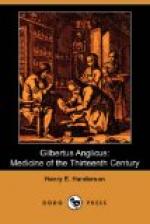In Italy alone did surgery vindicate for itself an equality with medicine, and the pioneer of this advance was Roger of Parma, who, as we have seen, flourished early in the thirteenth century. Roger and his pupil Roland, with the somewhat mythical “Four Masters” (Quatuor Magistri), were the surgical representatives of the School of Salernum, while Hugo (Borgognoni) di Lucca and his more famous son Theodorius represented the rival school of Bologna. Equally famous Italian surgeons of this century were Bruno of Logoburgo (in Calabria) and Gulielmus of Saliceto (1275), the master of Lanfranchi (1296). Gilbert of England, as a pupil of Salernum, naturally followed the surgical teachings of that school, and we have already noticed that his chapters on surgery are taken chiefly from the writings of Roger of Parma, though the name of neither Roger, nor indeed of any other distinctly surgical writer, is mentioned in the Compendium. How closely in some cases Gilbert followed his masters may best be seen by a comparison of their respective chapters upon the same subject. I accordingly introduce here for such comparison Roger’s chapter on wounds of the neck, and the corresponding chapter of Gilbert. Roger says:
“De vulnere quod fit in cervice.
“Si vero cum ense vel alio simili in cervice vulnus fiat, ita quod vena organica incidatur, sic est subveniendum. Vena tota sumatur (suatur) cum acu, ita quod vena non perforetur, et ex alia parte acus cum filo ei inhaerente ducatur, et cum ipso filo nectatur atque stringatur, quod sanguinem non emittat: et ita facias ex superiori parte et inferiori. In vulnere autem pannus infusus mittatur, non tamen de ipso vulnus multum impleatur. Embrocha, si fuerit in myeme, superponatur quosque (quousque) vulnus faciat saniem. Si vero fuerit in aestate vitellus avi semper superponatur. Quum autem saniem fecerit, cum panno sicco, unguento fusco et caeteris bonam carnem generantibus, adhibeatur cura, ut in caeteris vulneribus. Quum vero extremitatem venae superioris partis putruisse cognoveris, fila praedicta dissolvas, et a loco illo removeas: et deinde procedas ut dictum est superius. A. Si vero nervus incidatur in longum aut ex obliquo, sed non ex toto, hac cura potest consolidari. Terrestres enim vermes, idest qui sub terra nascuntur, qui in longitudine et rotunditate lumbricis assimilantur, et apud quondam terrestres lumbrici dicuntur, accipiantur et aliquantulum conterantur et in oleo infusi ad ignem calefiant: et nullo alio mediante, ter vel quater, vel etiam pluries, si opportunum videbis, plagae impone. Si vero incidatur ex obliquo totus, minime consolidatur: praedicto tamen remedio non coadjuvante saepe conglutinatur. Potest etiam cuticula, quae supra nervum est, sui, pulvisque rubens, qui jam dictus est, superaspergi, quae cura non est inutilis, aliquos enim non solum conglutinatas, sed etiam consolidatas, nostra cura prospeximus. Si vero locus tumet, embrocham illam, quam in prima particula ad tumorem removendum, qui ex percussura contigit, praediximus, ponatur, quousque talis tumor recesserit.”




